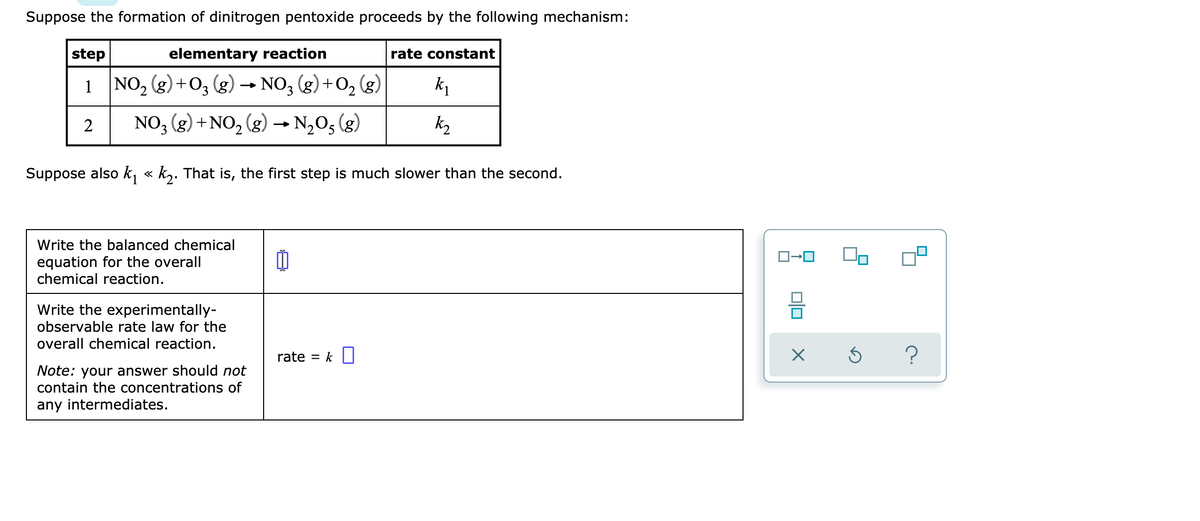Suppose the formation of dinitrogen pentoxide proceeds by the following mechanism: rate constant k₁ k₂ step elementary reaction 1 NO₂ (g) +03 (g) → NO3 (g) + O₂(g)| 2 NO3 (g) + NO₂(g) → N₂O5 (8) Suppose also k₁ «k₂. That is, the first step is much slower than the second. Write the balanced chemical equation for the overall chemical reaction. Write the experimentally- observable rate law for the overall chemical reaction. Note: your answer should not contain the concentrations of any intermediates. 0 rate = k
Suppose the formation of dinitrogen pentoxide proceeds by the following mechanism: rate constant k₁ k₂ step elementary reaction 1 NO₂ (g) +03 (g) → NO3 (g) + O₂(g)| 2 NO3 (g) + NO₂(g) → N₂O5 (8) Suppose also k₁ «k₂. That is, the first step is much slower than the second. Write the balanced chemical equation for the overall chemical reaction. Write the experimentally- observable rate law for the overall chemical reaction. Note: your answer should not contain the concentrations of any intermediates. 0 rate = k
Chemistry: Principles and Reactions
8th Edition
ISBN:9781305079373
Author:William L. Masterton, Cecile N. Hurley
Publisher:William L. Masterton, Cecile N. Hurley
Chapter11: Rate Of Reaction
Section: Chapter Questions
Problem 26QAP: When nitrogen dioxide reacts with carbon monoxide, the following reaction occurs. Â...
Related questions
Question
100%
TIA

Transcribed Image Text:Suppose the formation of dinitrogen pentoxide proceeds by the following mechanism:
elementary reaction
NO₂ (g) + 03 (g) → NO3 (g) + O₂
NO3 (g) + NO₂ (g) → N₂O5 (8)
Suppose also k₁ << kỵ. That is, the first step is much slower than the second.
step
1
2
Write the balanced chemical
equation for the overall
chemical reaction.
Write the experimentally-
observable rate law for the
overall chemical reaction.
Note: your answer should not
contain the concentrations of
any intermediates.
៣
rate =
k
O₂(g)
rate constant
k₁
k₂
ロ→ロ
010
X
Ś
?
Expert Solution
This question has been solved!
Explore an expertly crafted, step-by-step solution for a thorough understanding of key concepts.
This is a popular solution!
Trending now
This is a popular solution!
Step by step
Solved in 2 steps with 2 images

Knowledge Booster
Learn more about
Need a deep-dive on the concept behind this application? Look no further. Learn more about this topic, chemistry and related others by exploring similar questions and additional content below.Recommended textbooks for you

Chemistry: Principles and Reactions
Chemistry
ISBN:
9781305079373
Author:
William L. Masterton, Cecile N. Hurley
Publisher:
Cengage Learning

Chemistry by OpenStax (2015-05-04)
Chemistry
ISBN:
9781938168390
Author:
Klaus Theopold, Richard H Langley, Paul Flowers, William R. Robinson, Mark Blaser
Publisher:
OpenStax

Chemistry for Engineering Students
Chemistry
ISBN:
9781337398909
Author:
Lawrence S. Brown, Tom Holme
Publisher:
Cengage Learning

Chemistry: Principles and Reactions
Chemistry
ISBN:
9781305079373
Author:
William L. Masterton, Cecile N. Hurley
Publisher:
Cengage Learning

Chemistry by OpenStax (2015-05-04)
Chemistry
ISBN:
9781938168390
Author:
Klaus Theopold, Richard H Langley, Paul Flowers, William R. Robinson, Mark Blaser
Publisher:
OpenStax

Chemistry for Engineering Students
Chemistry
ISBN:
9781337398909
Author:
Lawrence S. Brown, Tom Holme
Publisher:
Cengage Learning

Chemistry: An Atoms First Approach
Chemistry
ISBN:
9781305079243
Author:
Steven S. Zumdahl, Susan A. Zumdahl
Publisher:
Cengage Learning


Chemistry
Chemistry
ISBN:
9781305957404
Author:
Steven S. Zumdahl, Susan A. Zumdahl, Donald J. DeCoste
Publisher:
Cengage Learning